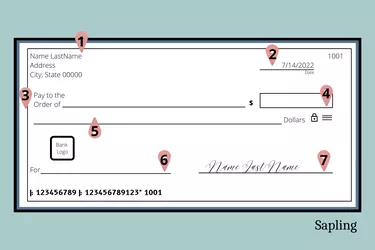
It's essential to know how to fill out a blank check. Writing checks isn't challenging, but there are some nuances. You need to write the correct dollar amount on the check. But what if the amount of the check is less than $1? Can this be written? If so, how do you write a cents-only check?
Did you know that it's illegal to write a check for less than $1?
Video of the Day
Video of the Day
Personal Check for Cents
According to a federal code from 1994, it is illegal to write the amount of the check to a payee for less than $1. The penalty for writing less than $1 is a possible six months in jail or a fine. So, beware if you're inclined to write an amount of the check for less than $1.
How to Write a Check
When writing a check, use a black or blue pen. Don't use a pencil. You want the check to be permanent.
There is a proper order for writing checks. When you tear a blank check from your checkbook, start filling out the date line first. It's located in the upper right corner of the check. It's beneath the check number and is number two on the check diagram. Make sure you have the current date.
Next, you'll want to designate a payee by writing the name of the person you're going to make the check out to. You'll find the line for this to the right of the words "Pay to the order of." Write the full name of the person. Don't use a nickname. The "Pay to the order of" is number three on the check diagram.
Writing Amount of the Check
After you've written out the payee name, it's time for the amount of the check. You'll start by writing the dollar amount in the box to the right side of a dollar sign. It's number four on the check diagram.
Write a numeric number in the box. Make sure the number is on the left side of the interior of the box close to the preprinted dollar sign. You don't have to write a dollar sign since it's already there. Write the amount of the check. For instance, if the amount of the check is $100.50, double check that you clearly wrote the decimal for the cents. If the decimal point isn't clear, your financial institution might think you wrote $10,050.
After you have written the numeric number, it's time to write it out in long hand. Go to the line below the "Pay to the order of" line to write the matching dollar amount on the check. You'll find this at number five on the check diagram.
On this line, in long-hand, write out "one hundred dollars and 50/100." Always put the change you have written over 100. It designates that out of 100 pennies you're paying 50. Double check that the amount in the numeric number in the box matches the written amount of the check. They must be the same amount. The written-out amount of the check takes precedence over the numerical amount if there is a discrepancy.
Memo Line Available
If you need to be reminded why you wrote the check, use the memo line when writing checks. For instance, if it's a gift, designate that in the memo line. You can put the vendor's account number in the memo line if you're paying a bill. The memo line is located in the bottom left hand corner of the check. It's number six on the check diagram.
Signature Line Is Mandatory
You are required to sign the check. Your signature informs your financial institution that you have authorized funds transfer to the payee. The signature line is located at the bottom right side of the check and is number seven on the check diagram.
Checking Account and Personal Finance
Writing checks can benefit your budgeting. With a debit card, it's too easy to spend without keeping track of what dollar amount you have left. Because a checking account comes with a check register, you can track your expenditures. So, even if they seem old fashioned, checks still come in handy.